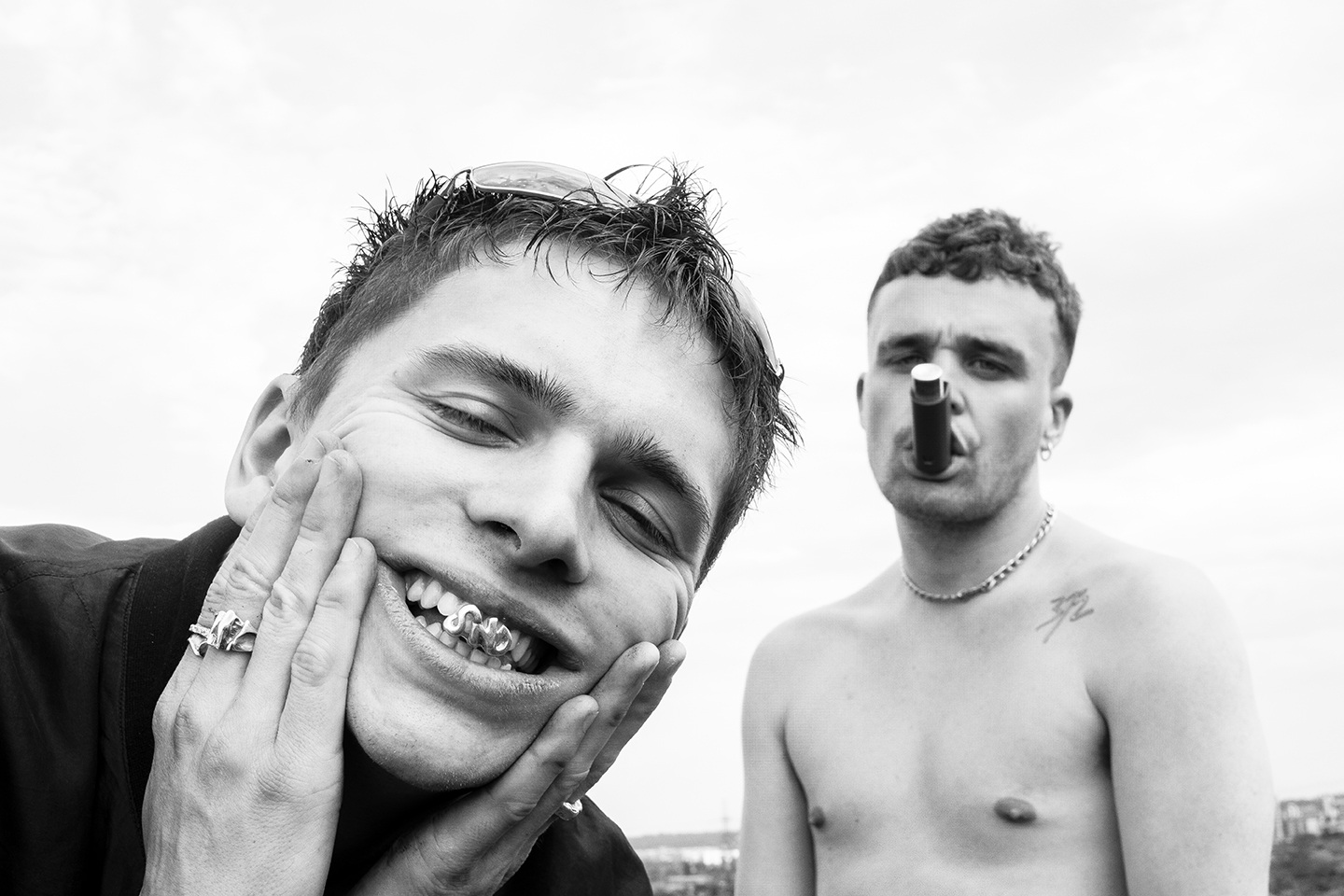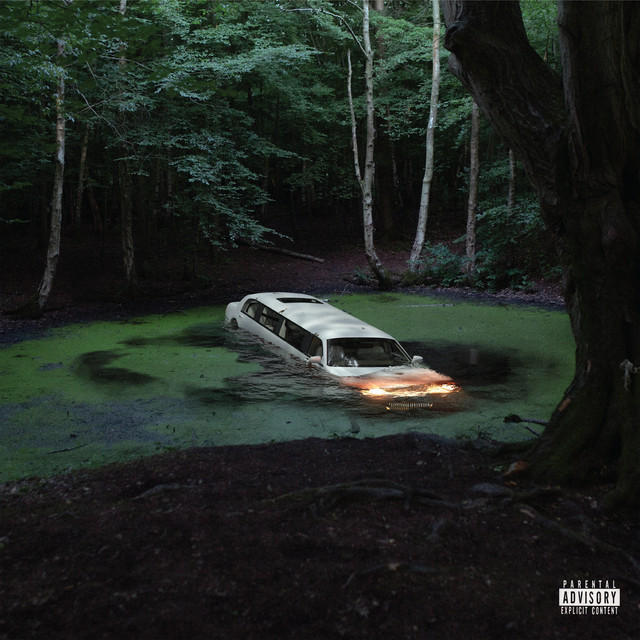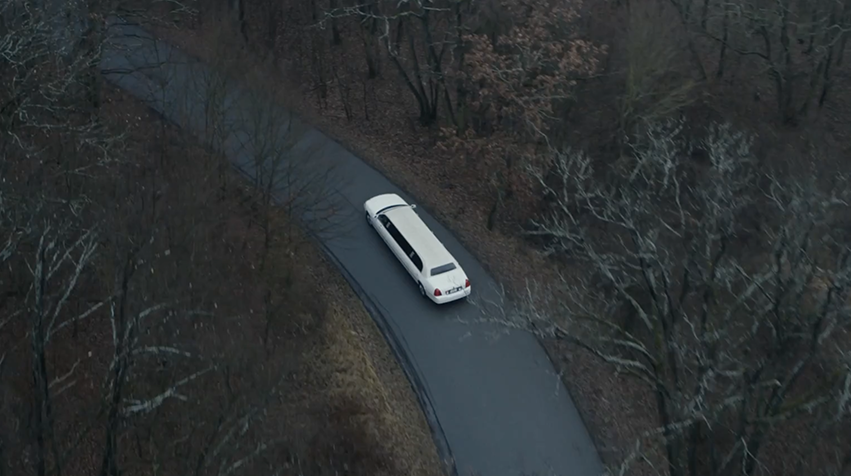
“Sad Night Dynamite” Brings Horror to Hip hop With Intention
Featured image by Kay Ibrahim.
Liminal sound on the edges of hip-hop, wave music and electronic, is on the rise in popular listening as 2023 transitions into 2024. One ear worm that has fully infiltrated the mind this year is a self-titled album by the iconic duo Sad Night Dynamite. Hailing from the UK, Sad Night Dynamite provides a gateway into their darkness, both terrifying and irresistible. Josh Greacen and Archie Blagden, originally from Glastonbury, are molding their genre with rigor while introducing conversations to the music scene.
Released in 2021, the project is filled with an undeniable darkness, communicated even through the album’s art. A limousine sinks into a dark pool surrounded by a lush, yet lifeless forest. The dark palette provides a catching contrast with the pale white car and the glowing headlights. Literally like watching a car crash, you can’t look away. It begs to be explored.

Beginning with distant chimes and the movement of a car across crumbling terrain, the first words “crying over nothing” come from the depths of the soundscape. Voices encourage the listener to “lay their head in the oven,” as the instruments drop in octave. Exiting as swiftly as the song began, mechanical whirring transitions into an emotionally detached chanting voice.
Funhouse mirrors of sound surround the listened, warbling and wavering over the mechanical and tight drums. “Icy Violence” curates waking up after an abduction, alien or pirate it’s hard to tell. Or perhaps you are stumbling drunk through the woods, it’s hard to say what is in your head and what is not. The remarkable production builds this effect, creating a truly spherical sound, take my word for it this is one for the headphones.
The automated beat holds steady within disorienting instrumentals. “Icy Violence” begs for wordplay, slipping in and out of the vocals with echoes of “I see violence” creeping into mind. A concerning mention of a gypsy builds the world hiding in darkness on the album cover. “Tie him to the tree, they’ll be so delighted,” voices titter with concerning excitement. Sounds from the deep recesses of any instrument pack fill out the scene.
Strings turn the song on its head as the lyrics lean into the nautical theme. Mentions of “the captain” and the beach reoccur throughout the song. Specifically, the captain is drawn into focus. “Handsome man with ugly features,” the voices describe in haunting effects. Littered with adlibs like any good hip-hop track the vocals incorporate a plethora of narrators through the two talented vocalists. A much more genuine narrator emerges with the end of the song, in a more even meeter, and the scene is calmed yet remains apprehensive.
“Killshot” brings the sound back into the modern day, with automation and intensity. An attached visual shows someone with binoculars in a parking garage, zooming in on someone with a scope. Heavy drums pound as the vocals swirl in and out of focus. “How you making love if you’re her dad?” questions the narrator. This implies further darkness causing the interaction between predator and prey. Perhaps a problematic father figure influenced the context of this song and Sad Night Dynamite defensively challenges him.
With the dystopic sounds of voices flitting across the melody, “Killshot” brings a sense of discomfort, “wondering if they’re ever getting home,” the narrator describes. At the same time, the drum kit grounds the song in a very stable way. The narrative continues as the narrator explains, “fuck it, girl, you can’t be fucking saved, Now he fucking knows about it, I could get a killshot running, But you might not love it.”
Urban violence continues. “We could chain my heels to your dirt bike,” growls the narrator before the song breaks away into ethereal melodies incorporating bits of Middle Eastern sound. The song closes with a threat and the clicking of a camera, who is to say how the altercation played out.
Opera builds and flows for mere seconds of the intro before whirring away with muffled laughter seemingly on an alternate plane. Within the hip-hop breakdown sitar builds eerie melodies and brings the sound back toward something more classical. “Don’t cry near me, oh,” the voice insists. The discussion of masculinity continues and highlights the effects it has on family ties. Hyper-masculine father figure “Mountain Jack” is passionately violent yet emotionally detached. “Calling from home’s a waste of time,” with the ringing of a phone in the distance reminds one of home, complications, and all.
Nature visuals from the beginning of the album continue, but with a shift. “Sun is coming down on jackals back,” brings word play between the name in the song title, to the coyote-like untamed animals that roam Africa and Eurasia. Mountain Jack specifically brings something harsher than the wooded imagery of the album cover. “Daddy’s come home and you don’t know why,” holds a weight despite the swiftness of the line. A rough mountaineer with children often left behind feels apt for this line, and the implications behind it are concerning.
As the song attempts to pan out, production takes hold, revving into a drum breakdown. Nearly illegible lyrics push themselves over the center-stage drums, almost blowing out any headphones and commanding the listener’s attention.
Following the darkness in content comes the catchiest song on the album, “Krunk” which holds a firm first place on the artist’s most popular songs. In addition to the bouncy melody, the title of the song draws attention on its own. “Krunk” builds onitself almost like a character. The incredibly modern word referencing the state experienced after overconsumption of substances (generally alcohol or drugs), walks the line between onomatopoeia and slang. Quickly the lyrics emphasize the word, “Oh my god, Krunk king God, Krunk killed God, Krunk is God.”
Strangely whimsical elements mixed with the discussion of the female body set this song apart from the album, though it potentially adds to the hyper masculine character being formed. The narrator tells a woman to “get a new face-lift” because he has been “looking [her] way and [her] face has gone through some changes.” This concerning portrayal feels self aware on the part of the writers, as quickly the song acknowledges, “On the coast, I’m a scary guy.”
Building the character further, the narrators describe, “le freak of the tower, wait in line for about an hour, just to shoot up her skirt and take a photo, that’s girl power.” The camera sound effects throughout the project carry a bit more weight following this line. This direct portrayal of obsession with the female body highlights the complexity.
The vocal distortion in this song, and on the project generally, brings a new wave sound and contributes to the characters being built. The removal of the real members of the duo through heavy effects creates a distance that some musicians don’t have with their work at any point. Auditorily it is difficult to know which member is singing and the lyrical distance from their lives remains very unknown through rather cryptic lyrics. Perhaps the raw emotion involved in the discussion is what encouraged Sad Night Dynamite to distance themselves from any character portrayed. The frustration expressed comes to a point, addressing the narrator with, “then you’ll go home and you’ll cry, Eat a tub of whatever suits you and ink over the dye.” Chaos is encouraged, “rock the boat think the Captains high.”
Static smooths the transition into “Crying over nothing (pt. II).” In just a minute, the interlude builds and washes away with lines from the first track on the album. “Crying over nothing,” the ominous chant begins. Methodical percussion drives forward the twisted circus melody to an unforeseen end. The persistent discussion of crying feels both affirming of emotion and uncomfortable as a representation of the dismissal some have toward this form of expression.
“Oh God oh no,
All my needs are in that phone
All my dreams are in that phone
My whole life is in that phone”
Building a discussion of addiction, or perhaps reliance on things that the duo sees as at their core unnecessary, the quick melody triggers something in any listener with a smartphone. Reality is grounded in an unsettling and personal way, though it is not uncalled for.
With a sustained note to transition into “Skully,” the beat punches its way into the soundscape with a classic kit sound. Nautical themes return as well as violent imagery. However, this round remorse is expressed. “If you find yourself a brain, pour it down the fucking drain, what a waste it’s such a shame.” The narrators describe a city turning into a ghost town, daughters fishing, floods and “men on roofs with guns which break our silence with violence.” This quick flashback to “Killshot” further builds the kind of insecurity that keeps you looking over your shoulder.
“Smoke Hole” breaks the albums fourth wall acknowledging “Drowned in effects oh, doesn’t know the sound though.” Musically, the song is littered with creative sound effects to build a unique portrayal of someone under the influence of competing drugs.
Scissor imagery and threats of genital mutilation bring the darkness to the front of the discussion. “Thought you’d never leave, now you’re back in prison, dirty old wizard” may be a mention of the problematic villains described in previous songs or a wholly new interaction in the alleged cityscape.
A high-pitched whine whizzes out of existence before dark layered sound rebuilds itself under the main melody. “Mussel Bay (outro)” acknowledges the finality of the album, and returns to a nautical theme. “Down in Mussel Beach where I was sailing once,” reminisces the narrator with a heavy heart.
Matching in tone the narrator laments, “I’m the guy with the Martians up above,” opening an exciting door to the project’s fuller reality. This is not all that surprising as many of the tracks slip noises reminiscent of the space technology we have culturally envisioned.
On the more realistic side of the album’s world, a white limousine drives down a foggy road past dark trees and thick mossy grass in an eerie visual. On Spotify, this imagery calls back to the very first song, bringing a cyclical visual to pair with the very cyclical melodies that move through the album. The clear investment in visual arts bodes well for the duo. Playing with all types of video editing and unsettling effects to provide a unique experience with almost every track.

As the project closes, a theme of motion feels particularly present, though less sickening than the dizzy rhythm of the songs. Perhaps with this self-titled album as the group’s first official project, the artists felt a distance from their past selves expanding. “I’m not the same,” the vocalist admits in the final song. There seems to be a nostalgia to their description of some unknown city, perhaps one of the future or the past.
In just under thirty minutes, the project is over and listeners are released from the hallucination to a jarring loss of auditory engagement. The album wastes no time, moving with the consistency of the tides, and ferocity of its subject matter. Passion comes from deep within and emotions churn under their own weight.
Momentum is only building for Sad Night Dynamite. Based on the passion and vigor put into their projects so far, there is no doubt you’re in for a hell of a live show. Check out their latest project Volume II or follow them on Instagram to follow Sad Night Dynamite during their musical metamorphosis.

